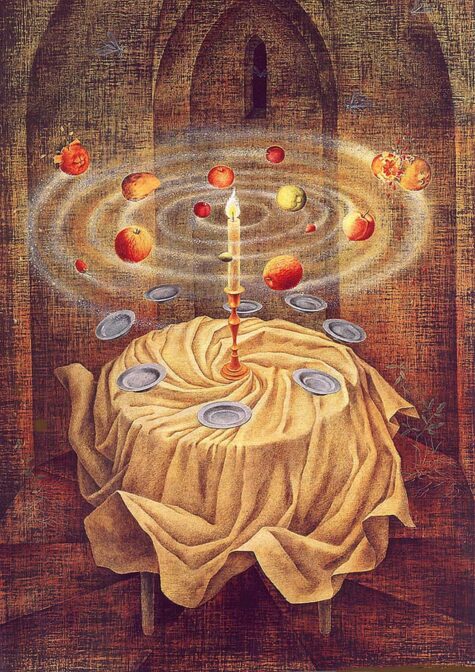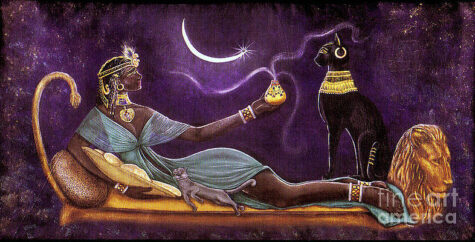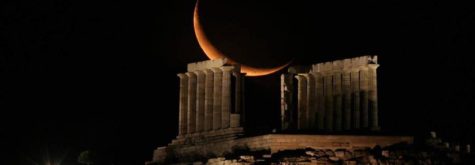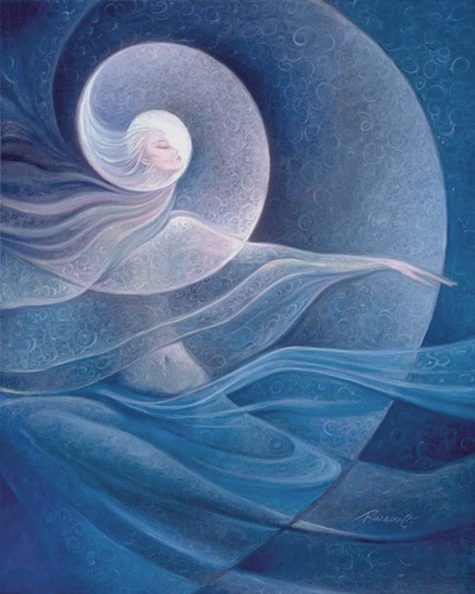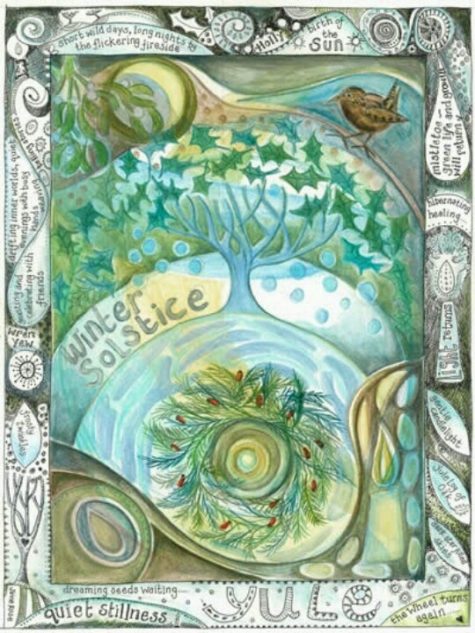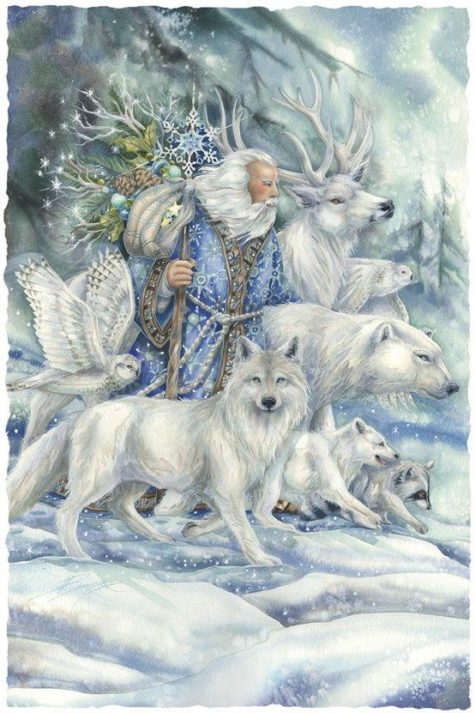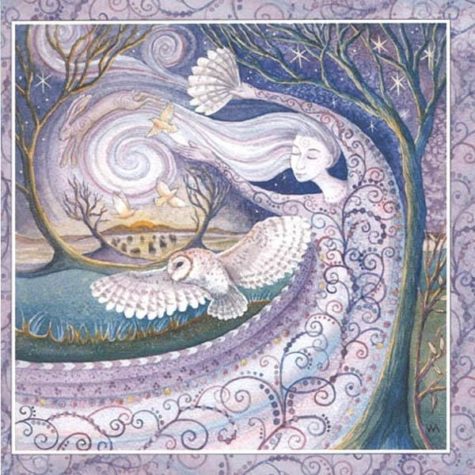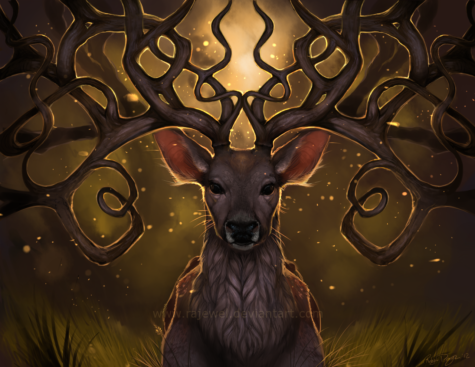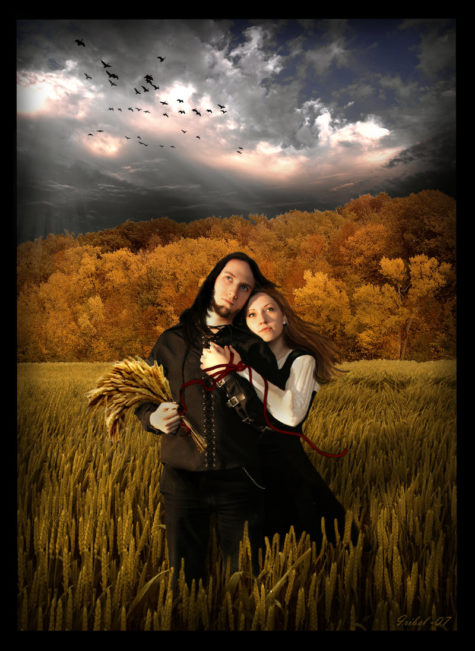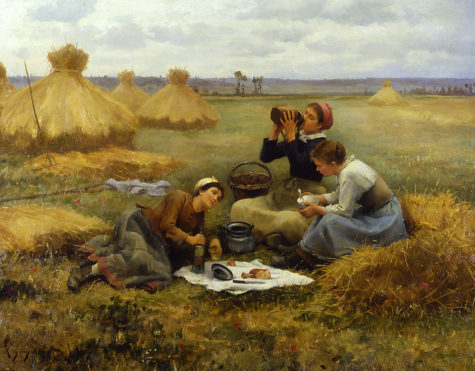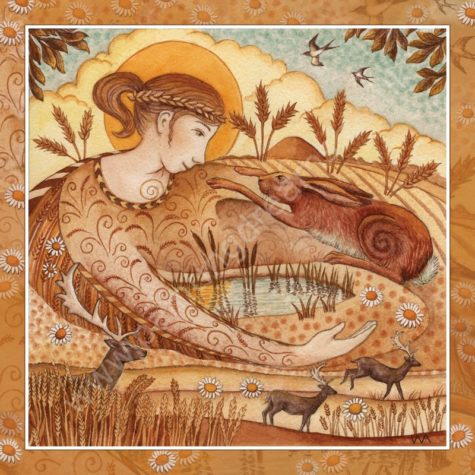Wheel of the Year
The Autumn Equinox – or Mabon – is a time of harvesting and celebration. Often called “Witches’ Thanksgiving,” it’s a prosperity holiday which asks us to gather with one another to count our blessings, connect, and re-balance. The nights are about to become longer, and soon we’ll be turning inward.
Mabon is a celebration of life and death, and giving of life again, the cycle of the seasons. Mabon is a time to enjoy the fruits of a hard year’s labor, to stock up for the long winter. No matter how you celebrate Mabon, it is important to know that Mabon a time for giving thanks.
The festival calendar of ancient Egypt, as it appears to us now, spans three thousand years of Egyptian history and probably was being recorded, observed, and manipulated many thousands of years before that. In those three millennia a great many political and religious changes affected the designated feast days. Some feasts fell out of favor, others were renamed, a few were entirely forgotten.
Many Egyptian feast days are moveable feasts, that is, they are lunar festivals timed to phases of the moon. Thus their occurrence might slip around from one year to the next. This is similar to how Easter Sunday, (the first Sunday following the first full moon after the vernal equinox), falls on a different date every year.
The Calendar
In any true sense it would be impossible for us to know the actual recurring dates of many of the festivals. We can, however, approximate the ancient dates. The Gregorian Calendar dates given here should not be taken as arbitrary or fixed, I think of them as a suggestion instead.
This particular calendar is from the book Feasts of Light. You may find that the dates of these various festivals are listed differently on other calendars. When planning a celebration in the Egyptian manner, use your intuition and your own understanding of the Lunar Calendar and the Wheel of the Year.
Season of Inundation – Akhet – Winter
During the Season of Inundation more major public festivals occurred than at any other time of the year, most of them related to fertility rites and abundance rituals. The feasts tended to occupy the general public during this time because the land was so flooded that little real work could be done.
Thuthi – The first month of winter
- 1 – The Rise of Sothis as Isis – July 19
- 1 – The Opening of the New Year – July 19
- 7 – The Feast of Anket – July 25
- 20 – The Inebriety of Hathor – August 7
Paopi – The second month of winter
- 5 – The Feast of Hathor and Min – August 22
- 15 – The Opet Festival – September 1
- 21 – Neith Goes Forth to Atum – September 7
Hethara – The third month of Winter
- 1 – Hathor’s Birthday Feast – September 17
- 17 – The Lamentations of Isis – October 3
- 21 – The Feast Day of Ma’at – October 8
- 30 – Opening the Bosom of Women – October 16
- 30 – The Feast of Isis in Busiris – October 16
Koiak – The fourth month of Winter
- 17 – The Plucking of the Papyrus for Hathor – November 2
- 27 to 29 – The Osirian Mysteries – November 12 to 14
- 27 – Isis Seeks the Body of Osiris – November 12
- 28 – Isis Grieves the Loss of Osiris – November 13
- 29 – Isis Rejoices as She Finds Osiris – November 14
Season of Sowing – Pert – Spring
Once the waters receded and work in the fields began, the Sowing season was the busiest time of the year.
Tybi – the first month Spring
- 19 and 20 – The Voyage of Hathor to Nubia – December 4 and 5
- 20 – Bast Goes Forth from Bubastis – December 5
- 28 to 30 – The Voyage of Hathor to Egypt and Her Father – December 13 to 15
Mechir – the second month of Spring
- 1 to 3 – The Voyage of Hathor to Egypt and Her Father( continued) – December 16 to 18
- 6 – The Feast of Isis the Black Cow – December 21
- 6 – The Festival of Raising the Djed of Osiris – December 21
- 10 – The Birth of Ra, Child of Nut – December 25
- 10 – The Birth of Horus, Child of Isis – December 25
- 19 – Isis Returns from Phoenicia with Osiris – January 3
- 21 – The Voyage of Hathor to See Her Seven Sisters – January 4
- 24 – Isis Greets Min in Coptos – January 8
Pamenot – the third month of Spring
- 5 – The Brilliant Festival of the Lights of Neith – January 19
Parmuti – the fourth month of Spring
- 20 – The Blessing of the Fleets by Isis – March 5
- 28 – Isis Births Horus the Younger – March 13
- 28 – Hathor Births Ihy – March 13
Season of the Harvest – Shemu – Summer
The growing season was quickly followed by the Harvest season. But during the final months of the year, when the harvest had ended and the land was dry, the festivals began again, mostly in anticipation of the coming Inundation.
Pachons – the first month of Summer
- 1 – The Feast of the Hand of the God – March 16
- 6 – The Pregnancy of Isis / Nut – March 21
- 15 – The Festival of Renenutet – March 30
- 19 – Isis Finds Osiris – April 3
Payni – the second month of Summer
- 1 – The Great Festival of Bast at Bubastis – April 15
- 26 – The Going Forth of Neith along the Water – May 10
Epiphi – the third month of Summer
- 1 – The Hierogamos of Hathor and Horus – May 15
- 4 – The Conception of Horus – May 18
- 5 – Hathor Returns to Punt – May 19
- 7 – The Sailing of the Gods after the Goddess – May 21
- 30 – The Festival of Mut: Feeding of the Gods – June 13
Mesore – the fourth month of Summer
- 3 – The Feast of Raet – June 16
- 3 – The Feast of Hathor as Sothis – June 16
The Epagomenal Days
The Egyptian year was divided into twelve months of thirty days each, which means that each year was about five days short of the astronomical year. To compensate for this difference, five extra days were added to the year, and (according to this particular calendar) are designated as follows:
- The Birthday of Osiris – July 14
- The Birthday of Horus the Elder – July 15
- The Birthday of Seth – July 16
- The Birthday of Isis (The Night of the Cradle) – July 17
- The Birthday of Nephthys – July 18
The Noumenia is the first day of the visible New Moon and is held in honor of the household Gods. The Noumenia is also considered the second day in a three day household celebration held each lunar month – Hekate’s Deipnon is on the last day before the first slice of visible moon and is the last day in a lunar month, then the Noumenia which marks the first day in a lunar month, followed by the Agathos Daimon (Good Spirit) on the second day of the Lunar month.
The Noumenia is a celebration of the start of a new Hellenic month and seeks blessings for the household. Offerings such as incense or honey cakes are made to your household Gods at your family altar.
- Here’s a recipe for Ancient Hellenic Honey Cakes.
Traditionally, the household Gods consist of Hestia, Zeus Ktesios, Hermes, Hekate, Apollon Agyieus, your household’s Agathos Diamons and can include any ancestors you honor. However, many Hellenic Polytheists do honor more Gods at their family altar.
You can celebrate the Noumenia with the following rituals:
- Decorate their home with fresh flowers, evergreen branches, or other seasonal decorations.
- Serve a big family meal and eat it at the dining room table.
- Create a list of family goals or projects to get done or start within the next lunar month.
- Bake a special dessert that you only make on this day – such as Honey Cake.
- Like the ancient Athenians, you can burn frankincense and read the Orphic and Homeric hymns to Selēnē.
- Replace the ingredients in the Kadiskos (see below) with fresh water, oil, and fruit, and bits of food.
The Kadiskos is a small jar containing food stuffs that we receive from the Gods and give back in reciprocity. Refreshing the Kadiskos is part of preparing for Noumenia. Here are directions for Making a Kadiskos.
Hellenic Worship:
Hellenic worship makes notice of the New Moon, because it marks the beginning of the month, rather than the more obvious full moon, although many Hellenic festivals are held during or near the time of the full moon.
“The first day of the month was new moon day (noumēnia), recognized as a holy day throughout the Greek world. It was so holy that at Athens, no other festival ever took place that day. It was celebrated by a public ritual on the Acropolis and by private offerings of frankincense to statues of the gods.”
Herodotus says that, in Sparta, meat, barley meal and wine were distributed to the citizens by the Kings on the Noumenia.
Hymn To Selene
Orphic Hymn 9 to Selene says that she “Delights in stillness and in the kindly, auspicious night.” Many of the Orphic hymns, and this one especially, reminds us that the arrival and passage of each new month is a reflection of the cycle of lives, with birth following the period of dark death. So as She is “a sure token and a sign to mortal men,” so we can trust in the cycle of rebirth and renewal.
Orphic Hymn 9 ~
Fumigation from Aromatics
Hear, goddess queen (thea basileia), diffusing silver light, bull-horned, and wandering through the gloom of night.
With stars surrounded, and with circuit wide night’s torch extending, through the heavens you ride: female and male, with silvery rays you shine, and now full-orbed, now tending to decline.
Mother of ages, fruit-producing Mene (Moon), whose amber orb makes night’s reflected noon: lover of horses, splendid queen of night, all-seeing power, bedecked with starry light, lover of vigilance, the foe of strife, in peace rejoicing, and a prudent life: fair lamp of night, its ornament and friend, who givest to nature’s works their destined end.
Queen of the stars, all-wise Goddess, hail! Decked with a graceful robe and amble veil.
Come, blessed Goddess, prudent, starry, bright, come, moony-lamp, with chaste and splendid light, shine on these sacred rites with prosperous rays, and pleased accept thy suppliants’ mystic praise.
More Hymns, Prayers, and Invocations can be found at Widdershins.
A Prayer For The Noumenia
In honor of the Noumenia of Anthesterion:
I have seen the moon
thin curved glow
hovering on delicate breeze
divine above the pink horizon
gentle horns pointing
toward tomorrow
We are all re-born now
owning no past
Yesterday is cleansed
complete
Greetings to you,
Goddess!
Guide us around
the next cycle of life
until we meet again
May we use it wisely
~ by Melissa
Source: Hellenion.org
Each month has specific flowers associated with it. This list is similar to, but not the same as the flowers associated with specific astrological signs.
Here’s the list:
- January – Carnation, Snowdrop.
- February – Violet, Primrose.
- March – Daffodil, Jonquil.
- April – Daisy, Sweet Pea.
- May – Lily-of-the-Valley, Hawthorn.
- June – Rose, Honeysuckle.
- July – Water Lily, Larkspur.
- August – Gladiolus, Poppy.
- September – Aster, Morning Glory.
- October – Cosmos, Calendula.
- November – Chrysanthemum.
- December – Narcissus, Holly.
Winter Solstice has been celebrated in cultures the world over for thousands of years. This start of the solar year is a celebration of Light and the rebirth of the Sun. In old Europe, it was known as Yule, from the Norse, Jul, meaning wheel.
Today, many people in Western-based cultures refer to this holiday as “Christmas.” Yet a look into its origins of Christmas reveals its Pagan roots.
Emperor Aurelian established December 25 as the birthday of the “Invincible Sun” in the third century as part of the Roman Winter Solstice celebrations. Shortly thereafter, in 273, the Christian church selected this day to represent the birthday of Jesus, and by 336, this Roman solar feast day was Christianized. January 6, celebrated as Epiphany in Christendom and linked with the visit of the Magi, was originally an Egyptian date for the Winter Solstice.
Most of the customs, lore, symbols, and rituals associated with “Christmas” actually are linked to Winter Solstice celebrations of ancient Pagan cultures. While Christian mythology is interwoven with contemporary observances of this holiday time, its Pagan nature is still strong and apparent.
Pagans today can readily re-Paganize Christmastime and the secular New Year by giving a Pagan spiritual focus to existing holiday customs and by creating new traditions that draw on ancient ways. Here are some ways to do this: Celebrate Yule with a series of rituals, feasts, and other activities.
In most ancient cultures, the celebration lasted more than a day. The ancient Roman Saturnalia festival sometimes went on for a week. Have Winter Solstice Eve and Day be the central focus for your household, and conceptualize other holiday festivities, including New Year’s office parties and Christmas visits with Christian relatives, as part of your Solstice celebration. By adopting this perspective, Pagan parents can help their children develop an understanding of the multicultural and interfaith aspects of this holiday time and view “Christmas” as just another form of Solstice.
Have gift exchanges and feasts over the course of several days and nights as was done of old. Party hearty on New Year’s Eve not just to welcome in the new calendar year, but also to welcome the new solar year.
Adorn the home with sacred herbs and colors. Decorate your home in Druidic holiday colors red, green, and white. Place holly, ivy, evergreen boughs, and pine cones around your home, especially in areas where socializing takes place.
Hang a sprig of mistletoe above a major threshold and leave it there until next Yule as a charm for good luck throughout the year. Have family/household members join together to make or purchase an evergreen wreath. Include holiday herbs in it and then place it on your front door to symbolize the continuity of life and the wheel of the year. If you choose to have a living or a harvested evergreen tree as part of your holiday decorations, call it a Solstice tree and decorate it with Pagan symbols.
Convey love to family, friends, and associates. At the heart of Saturnalia was the custom of family and friends feasting together and exchanging presents. Continue this custom by visiting, entertaining, giving gifts, and sending greetings by mail and/or phone. Consider those who are and/or have been important in your life and share appreciation.
Reclaim Santa Claus as a Pagan Godform. Today’s Santa is a folk figure with multicultural roots. He embodies characteristics of:
- Saturn (Roman agricultural god)
- Cronos (Greek god, also known as Father Time)
- Holly King (Celtic god of the dying year)
- Father Ice/Grandfather Frost (Russian winter god)
- Thor (Norse sky god who rides the sky in a chariot drawn by goats)
- Odin/Wotan (Scandinavian/Teutonic All-Father who rides the sky on an eight-legged horse)
- Frey (Norse fertility god)
- Tomte (a Norse Land Spirit known for giving gifts to children at this time of year)
Santa’s reindeer can be viewed as forms of Herne, the Celtic Horned God. Decorate your home with Santa images that reflect His Pagan heritage.
Honor the Goddess as Great Mother. Place Pagan Mother Goddess images around your home. You may also want to include one with a Sun child, such as Isis with Horus. Pagan Goddess forms traditionally linked with this time of year include:
- Tonantzin (Native Mexican corn mother)
- Holda (Teutonic earth goddess of good fortune)
- Bona Dea (Roman women’s goddess of abundance and prophecy)
- Ops (Roman goddess of plenty)
- Au Set/Isis (Egyptian/multicultural All Goddess whose worship continued in Christian times under the name Mary)
- Lucina/St. Lucy (Roman/Swedish goddess/saint of light)
- Befana (Italian Witch who gives gifts to children at this season)
Honor the new solar year with light. Do a Solstice Eve ritual in which you meditate in darkness and then welcome the birth of the sun by lighting candles and singing chants and Pagan carols.
If you have a indoor fireplace or an outdoor fire circle, burn an oak log as a Yule log and save a bit to start next year’s fire. Decorate the inside and/or outside of your home with electric colored lights. Because of the popularity of five pointed stars as holiday symbols, this is a good time to display a pentagram of blue or white lights.
Contribute to the manifestation of more wellness on Planet Earth. Donate food and clothing to poor in your area. Volunteer time at a social service agency. Put up bird feeders and keep them filled throughout the winter to supplement the diets of wild birds. Donate funds and items to non-profit groups, such as Pagan/Wiccan churches and environmental organizations. Meditate for world peace. Work magic for a healthier planet. Make a pledge to do some form of good works in the new solar year.
by Selena Fox
The Winter Solstice or Yule is one of the Lesser Wiccan Sabbats, and it is also the shortest day of the year, and hence – the longest night. This usually takes place on December 20th or 21st, although it does sometimes occur on the 22nd or 23rd (check your calendar as it changes from year to year).
Other than the most common name of Yule, various other names for the Winter Solstice include:
- Midwinter
- Yuletide (the Teutonic version)
- Alban Arthan (Caledonii Tradition, or the Druids)
- Feill Fionnain (Pecti-Wita Tradition, which falls on December 22nd).
Yuletide lasts from December 20th through December 31st. It begins on “Mother Night” and ends twelve days later, on “Yule Night”, hence the “Twelve Days of Christmas” tradition. Alban Arthan, unlike all the others, is not considered a fire festival.
Some other names for this Sabbat that are used less commonly are: Sun Return, Pagan New Year, Saturnalia (Roman), Great Day of the Cauldron, and Festival of Sol.
Yule is a time of the Goddess of the Cold Darkness and the birth of the Divine Child, the reborn Sun God. It is a time of renewal and rebirth during Winter, and the turning of the Earth force tides. A time when the waxing Sun overcomes the waning Sun. In some traditions, this is symbolized by the struggle between the Oak King and the Holly King.
The Holly King, represents the Death aspect of the God at this time of year; and the Oak King, represents the opposite aspect of Rebirth (these roles are reversed at Midsummer). This can be likened to the Divine Child’s birth. The myth of the Holly King/Oak King probably originated from the Druids to whom these two trees were highly sacred. The Oak King (God of the Waxing Year) kills the Holly King (God of the Waning Year) at Yule (the Winter Solstice). The Oak King then reigns supreme until Litha (the Summer Solstice) when the two battle again, this time with the Holly King victorious.
Examples of the Holly King’s image can be seen in our modern Santa Claus. He dons a sprig of holly in his hat, wears red clothing, and drives a team of eight (total number of Solar Sabbats) reindeer, an animal sacred to the Celtic Gods (deer). Mistletoe and holly came into modern Christmas celebrations through the memorializing of this battle. The holly with berries are hung in honor of the Holly King and mistletoe in honor of the Oak King. Although the Holly King and Oak King are mortal enemies at the two Solstices – Yule and Litha – it should be remembered that they are actually two sides of one whole, and neither would exist without the other.
Since this is a Solar Festival, it is celebrated by fire and the use of many candles orthe Yule Log. The colors of the season – red and green – are of original Pagan descent. Symbols representing Yule include an eight-spoked wheel symbol, evergreens, wreaths, holly, mistletoe, Yule Trees (very similar to the familiar “Christmas Trees”), or a small potted tree, and Yule Logs.
The act of decorating the Yule Tree, wreaths of holly, and the exchange of gifts are also Pagan derivatives. The Yule Tree can be a living, potted tree which can later be planted in the ground, a cut one, or even an artificial one. The choice is yours.
Appropriate Wiccan decorations range from strings of dried rosebuds, cinnamon sticks, popcorn or cranberries for garlands to bags of fragrant spices hung from boughs. Quartz crystals can be wrapped with shiny wire and suspended from sturdy branches to resemble icicles. Apples, oranges, lemons, nuts of all kinds and cookies hanging from boughs and branches are strikingly beautiful; and can be real or artificial, depending on your taste. These natural decorations were customary in ancient times. The reindeer stag is also a reminder of the Horned God. You will find that many traditional Christmas decorations have some type of Pagan ancestry or significance that can be added to your Yule holiday.
Deities to honor at this time of year include all Newborn Gods and Sun Gods, and all Mother Goddesses and Triple Goddesses. Appropriate Yule Gods include Apollo (Greek), Ra, Osiris, Horus, (all three are Egyptian), Lugh (Irish-Celtic), Odin (Norse), Father Sun (Native American), and Jesus (Christian-Gnostic), to name a few. Goddesses might include the Morrigan, Brigit (both Celtic), Isis (Egyptian), Demeter, Gaea, Pandora, Selene, and Artemis (all five are Greek), Juno and Diana (both Roman), Astarte (Middle Eastern), Spinning Woman (Native American) and the Virgin Mary (Christian-Gnostic).
Ritually, you may want to light fires within the Circle (in the cauldron, for instance), light candles and carry them around the Circle or bring the Yule log into the Circle and include it in your ceremony. Bayberry candles can be burned to ensure prosperity, growth and happiness throughout the following year. These can be inscribed with runes for health and money, or whatever is desired before lighting. They shall be lit at sunset and allowed to burn until they go out by themselves. An old Germanic poem says “A bayberry candle burned to the socket brings food to the larder and gold to the pocket.”
Spellwork for balance, beauty, peace, and harmony are great to perform at this time of the Pagan year. Love spells and spells to increase happiness are also appropriate. Key actions to remember for Yule are introspection and meditation.
The most common colors used at this Sabbat are red and green, but gold and white are also quite appropriate. Stones to be used at this celebration include bloodstones, rubies, and garnets. Animals associated with the Yule Sabbat are stags, squirrels, wrens and robins. Mythical creatures associated with Yule are the Phoenix, and trolls. Herbs and plants that can be used include holly, mistletoe, evergreens, poinsettias, bay, pine, ginger, valerian, and myrrh.
The foods of Yule include nuts, fruits such as apples and pears, cookies and cakes of caraway soaked in cider, and (for non-vegetarians) pork are all traditional fare. Fine drinks for the Yule celebration or meals include Wassail (a hot drink made from wine, beer or cider, spices, sugar, and usually baked apples—served in a large bowl), lamb’s wool (ale mixed with sugar, nutmeg and the pulp of roasted apples), hibiscus or ginger tea, and apple cider.
Source: Citadel of The Dragons
Lughnasadh (pronounced “LOO-nahs-ah”) aka Lammas, is one of the Greater Wiccan Sabbats and is usually celebrated on August 1st or 2nd, although occasionally on July 31st. The Celtic festival held in honor of the Sun God Lugh (pronounced “Loo”) is traditionally held on August 7th. Some Pagans celebrate this holiday on the first Full Moon in Leo.
Other names for this Sabbat include the First Harvest Festival, the Sabbat of First Fruits, August Eve, Lammastide, Harvest Home, Ceresalia (Ancient Roman in honor of the Grain Goddess Ceres), Feast of Bread, Sabbat of First Fruits, Festival of Green Corn (Native American), Feast of Cardenas, Cornucopia (Strega), Thingtide and Elembiuos. Lughnassadh is named for the Irish Sun God Lugh (pronounced Loo), and variant spellings for the holiday are Lughnassadh, Lughnasad, Lughnassad, Lughnasa or Lunasa. The most commonly used name for this Sabbat is Lammas, an Anglo-Saxon word meaning “loaf-mass”.
At Lammas, the hot days of August are upon us, much of the earth is dry and parched, but we still know that the bright reds and yellows of the harvest season are just around the corner. Apples are beginning to ripen in the trees, our summer vegetables have been picked, corn is tall and green, waiting for us to come gather the bounty of the crop fields. Now is the time to begin reaping what we have sown, and gathering up the first harvests of grain, wheat, oats, and more.
It’s the dog days of summer, the gardens are full of goodies, the fields are full of grain, and the harvest is approaching. Take a moment to relax in the heat, and reflect on the upcoming abundance of the fall months. At Lammas, sometimes called Lughnasadh, it’s time to begin reaping what we have sown throughout the past few months, and recognize that the bright summer days will soon come to an end.
Depending on your individual spiritual path, there are many different ways you can celebrate Lammas, but typically the focus is on either the early harvest aspect, or the celebration of the Celtic god Lugh. It’s the season when the first grains are ready to be harvested and threshed, when the apples and grapes are ripe for the plucking, and we’re grateful for the food we have on our tables.
Lammas is a time of excitement and magic. The natural world is thriving around us, and yet the knowlege that everything will soon die looms in the background. This is a good time to work some magic around the hearth and home.
This is also a time when the God mysteriously begins to weaken as the Sun rises farther in the South, each day grows shorter and the nights grow longer. The Goddess watches in sorrow as She realizes that the God is dying, and yet lives on inside Her as Her child. It is in the Celtic tradition that the Goddess, in her guise as the Queen of Abundance, is honored as the new mother who has given birth to the bounty; and the God is honored as the God of Prosperity.
Deities associated with Lughnassadh are all Grain and Agriculture Deities, Sun Gods, Mother Goddesses and Father Gods. Particular emphasis is placed on Lugh, Demeter, Ceres, the Corn Mother and John Barleycorn (the personification of malt liquor).
Activities appropriate for this time of the year are:
- Baking bread – especially bread baked in the form of a God-figure or Sun Wheel
- Wheat weaving – such as the making of Corn Dollies, or other God and Goddess symbols which may be used both as a fertility amulet and an altar centerpiece.
- Sand candles can be made to honor the Goddess and God of the sea.
- You may want to string Indian corn on black thread to make a necklace,
- Bake corn bread sticks shaped like little ears of corn
Other actions include the gathering of first fruits and the study of Astrology. Some Pagans symbolically throw pieces of bread into a fire during the Lammas ritual. Spellwork for prosperity, abundance and good fortune are especially appropriate now, as well as spells for connectedness, career, health and financial gain.
The celebration of Lammas is a pause to relax and open yourself to the change of the Season so that you may be one with its energies and accomplish what is intended. Visits to fields, orchards, lakes and wells are also traditional. It is considered taboo not to share your food with others.
Correspondences for Lughnasadh:
- Colors: red, orange, gold, and yellow. Also green, citrine and gray.
- Candles: golden yellow, orange, green, or light brown.
- Stones: yellow diamonds, aventurine, sardonyx, peridot and citrine.
- Animals: roosters and calves.
- Mythical creatures: phoenix, griffins, basilisks, centaurs and speaking skulls.
- Plants: corn, rice, wheat, rye, ginseng, ash tree.
- Herbs: vervain, acacia flowers, aloes, cornstalks, cyclamen, fenugreek, frankincense, heather, hollyhock, myrtle, oak leaves, sunflower, and wheat.
- Incense: aloes, rose, rose hips, rosemary, chamomile, passionflower, frankincense, and sandalwood.
Traditional Pagan Foods for the Lughnassadh Festival include homemade breads (wheat, oat and especially cornbread), corn, potatoes, berry pies, barley cakes, nuts, wild berries, apples, rice, roasted lamb, acorns, crab apples, summer squash, turnips, oats, all grains and all First Harvest foods. Traditional drinks are elderberry wine, ale and meadowsweet tea.
It is also appropriate to plant the seeds from the fruit consumed in ritual. If the seeds sprout, grow the plant with love and as a symbol of your connection to the Divine. A cake is sometimes baked, and cider is used in place of wine.
Key actions associated with Lammas are receiving and harvesting, honoring the Parent Deities, honoring the Sun Gods and Goddesses, as well as celebration of the First Harvest.
From: PaganWiccan and other sources,
Lammas and Lughnasadh are ancient Pagan festivals celebrated in many parts of the world. Typically falling on the first day of August, these festivals celebrate the fruits of the first harvest of the year with a focus upon gratitude and blessings for abundance. The names Lammas and Lughnasadh are often used interchangeably which can create some confusion but the following will help to clear things up.
Lughnasadh, which is pronounced LOO-nah-sah, traces its roots far back into Irish history. In Celtic mythology the god Lugh is said to have held a funeral feast in honor of his foster mother Tailtiu, who died after clearing the plains of Ireland for the purpose of agriculture.
The festival of Lughnasadh became a day based upon this Celtic myth and historically it was a day of contests, games, handfasting or marriage, and seeking lodging for the long winter months. It was also one of the four main festivals of the Irish medieval calendar signaling the height of summer and the approach of autumn. The word Lughnasadh means “marriage of Lugh” which again ties in with Celtic mythology, for the god Lugh was seen as married to the land, or earth, and sacrificed to the earth. This is symbolic of crops being planted and then “sacrificed” in harvest.
Many modern-day Pagans celebrate the festival of Lughnasadh in a variety of ways, depending upon the Pagan tradition that they follow and their personal preferences. In Wicca, Lughnasadh is viewed as one of the eight sabbats that make up the Wheel of the Year. In Dianic Wicca often focus primarily upon the Goddess aspect in the form of the Goddess of plenty, Kore and Ceres or Habondia.
Celtic Reconstructionists base the celebrations of Lughnasadh largely upon historical research of the polytheist beliefs of the ancient Celts and typically celebrate it on the day of the full moon that falls closest to the festival. They often recognize the day by giving thanks and asking the deities to grant them a bountiful harvest. Many Celtic Reconstructionists will also honor the goddess Tailtiu on this day.
- More about Lughnasadh can be found here: Lughnasadh aka Lammas
Lammas was the name used in medieval England for the Christian holiday that celebrated early harvest. An Anglo-Saxon word, Lammas is thought to be a combination of the words loaf mass, the reason being that in medieval times it was typical for loaves of bread baked from the grains of the first harvest to be blessed during a church ceremony at that time.
However, Lammas was originally a Pagan harvest festival that, like Lughnasadh was one of gratitude and celebrating the first grains of harvest even though, in some parts of the world, it was incorporated into the Christian church.
- More about Lammas can be found here: Lammas – A Feast of Bread
Today Lammas is viewed primarily as a Pagan festival and many modern-day Pagans view Lammas and Lughnasadh as the same thing although the history behind each of the names is slightly different.
Lammas is very old indeed. It derives from the ancient English festival the Gule of August, which marked the beginning of the harvest, traditionally August 1.
The early English church kept this pagan dedication of the first fruits but converted it to Christian usage. The word Lammas derives from the Old English phrase hlaf-maesse, which translates to loaf mass. In early Christian times, the first loaves of the season were blessed by the Church.
Through the centuries, “loaf-mass” became corrupted in spelling and pronunciation to Lammas. On Lammas Day, loaves of bread were baked from the first-ripened grain and brought to the churches to be consecrated.
To the Celts, this was Lughnasaid, the feast of the wedding of the Sun god and the Earth goddess, and also a harvest festival. In Ireland, baskets of blueberries are still offered to a sweetheart in commemoration of the original fertility festival. In Scotland, the Lammastide fairs became famous for trial marriages that could be ended without question after a year.
“After Lammas Day, corn ripens as much by night as by day.”
In early Ireland, it was a bad idea to harvest your grain any time before Lammas – it meant that the previous year’s harvest had run out early, and that was a serious failing in agricultural communities. However, on August 1, the first sheaves of grain were cut by the farmer, and by nightfall his wife had made the first loaves of bread of the season.
Bread is the ultimate symbol of the Lammas season. After all, once the grain is harvested, it is milled and baked into bread, which is then consumed. It is the cycle of the harvest come full circle. The spirit of the grain god lives on through us in the eating of the bread. In many traditions, a loaf of special bread is baked in the shape of a man, to symbolize the god of the harvest.
You can easily make a loaf of Lammas bread by using a pre-made loaf of bread dough, found in the frozen food section in your grocery store. Certainly, you can make your own dough, but if you’re not much of a baker, this is an easy alternative. Or, if you prefer to make your own, here’s a recipe: Lammas Bread
Sources: The Fairy Party Book and Almanac.com
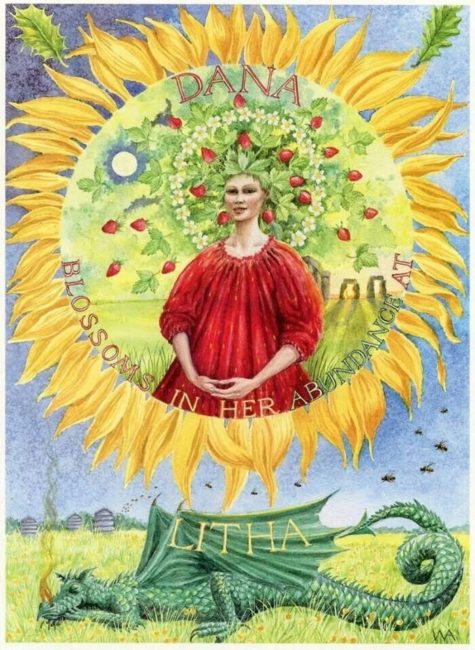 Litha (pronounced “LITH-ah”) is one of the Lesser Wiccan Sabbats and is usually celebrated on June 21st, but varies somewhat from the 20th to the 23rd, dependent upon the Earth’s rotation around the Sun (check the calendar).
Litha (pronounced “LITH-ah”) is one of the Lesser Wiccan Sabbats and is usually celebrated on June 21st, but varies somewhat from the 20th to the 23rd, dependent upon the Earth’s rotation around the Sun (check the calendar).
According to the old folklore calendar, Summer begins on Beltane (May 1st) and ends on Lughnassadh (August 1st), with the Summer Solstice midway between the two, marking MID-Summer. This makes more logical sense than suggesting that Summer begins on the day when the Sun’s power begins to wane and the days grow shorter.
The Litha Sabbat is a time to celebrate both work and leisure, it is a time for children and childlike play. It is a time to celebrate the ending of the waxing year and the beginning of the waning year, in preparation for the harvest to come. Midsummer is a time to absorb the Sun’s warming rays and it is another fertility Sabbat, not only for humans, but also for crops and animals.
Wiccans consider the Goddess to be heavy with pregnancy from the mating at Beltane – honor is given to Her. The Sun God is celebrated as the Sun is at its peak in the sky and we celebrate His approaching fatherhood – honor is also given to Him. The faeries abound at this time and it is customary to leave offerings – such as food or herbs – for them in the evening.
The cycle of fertility has been expressed in many god-forms. One pair of these – which has persisted from early Pagan times to modern folklore – is that of the Oak King and the Holly King, Gods respectively of the Waxing Year and the Waning Year. The Oak King rules from Midwinter to Midsummer – the period of Fertility, Expansion and Growth; while the Holly King reigns from Midsummer to Midwinter – the period of Harvest, Withdrawal and Wisdom.
They are the light and dark twins, each being the other’s alternate self, thus being one. Each represents a necessary phase in the natural rhythm, therefore both are good. At the two changeover points, they symbolically meet in combat. The incoming twin – the Oak King at Midwinter, the Holly King at Midsummer – “slays” the outgoing one. But the defeated twin is not actually considered dead – he has merely withdrawn during the six months of his brother’s rule.
On Midsummer Night, field and forest elves, sprites, and fairies abound in great numbers – making this a great time to commune with them. Litha is considered one of the best times to perform magicks of all kinds, for it is considered a time of great magickal power. Especially effective magick and spells at this time include the performance of those for love, healing and prosperity. A wreath can be made for your door with yellow feathers for prosperity and red feathers for sexuality – intertwined and tied together with ivy.
This is also a very good time to perform blessings and protection spells for your pets or other animals. You may want to choose to include your pet within your cast Circle at this Sabbat celebration, and even present him or her with a special gift (such as a tiny pentacle to attach to his or her collar). I have done this and found it very rewarding and heartwarming.
Nurturing and love are key actions related to Midsummer. If you haven’t yet done so, Litha is a good time to perform your Self-Dedication Ceremony… or – if you have been practicing Wicca for a while – you may choose to perform a simple Re-dedication/Affirmation as a part of your Sabbat celebration. Ritual actions for Litha might include placing a flower-ringed cauldron upon your altar, plunging of the sword (or athame) into the cauldron, balefire leaping (outdoors) and the gathering and drying of herbs. Herbs can be dried over the ritual fire if you’re celebrating outdoors. Leap the bonfire for purification and renewed energy. Ritually, use mirrors to capture the light of the Sun or the flames of the fire.
Found at: Fortune City
